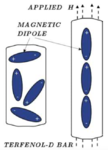I'd direct your attention, Miner, to the closing paragraph of the above geological article:
"We do not reject the theory of Magnetoplasticity, this idea of Mr. Buchachenko deserves the highest marks, but in explaining the source of earthquakes and the process of prevention of underground shocks it will not work. Although, staking on the magnetic field, the scientist came close to solving the
phenomenon of sudden movement of rock blocks - the source of earthquakes is an elementary
charge that creates a magnetic field."
The article, while rejecting Reid's original theory, it also recognizes that Mr Buchachenko's introduction of magnetoplasticity is not the answer either.
Gerhard Kostorz and Peter Mullner, in their article "Magnetoplasticity" in
Zeitschrift für Metallkunde 96(7) state:
Magnetocrystalline anisotropy and twinned microstructure are at the origin of the appreciable magnetic-field-induced strains found in some ferromagnetic thermoelastic martensites. The change of magnetization across the twinning plane leads to a force on the twinning dislocations when a magnetic field is applied. The sensitivity of this basic microscopic mechanism not only to crystallographic and magnetic properties of the material, but also to microstructural details, leads to a large variance in the macroscopically attainable magnetic-field-induced strains, while the maximum strain is fixed for any given martensite structure. The magnetic-field-induced deformation of Ni -Mn-Ga single crystals was studied in uniaxial ("static") and rotating ("dynamic") magnetic fields. The spatial and orientational distribution of martensite domains, twin thickness and mutual interactions between twinning dislocations all contribute to the macroscopic result.
See:
https://www.researchgate.net/publication/40622986_Magnetoplasticity
Y.D. Wang, in his article "Direct evidence on magnetic-field-induced phase transition in a NiCoMnIn Inferromagnetic shape memory alloy under a stress field", states:
The magnetoelasticity and magnetoplasticity behaviors of a Ni–Co–Mn–In ferromagnetic shape memory alloy (FSMA) induced by the reverse phase transformation interplayed under multiple (temperature, magnetic, and stress) fields were captured directly by high-energy synchrotron x-ray diffraction technique. The experiments showed the direct experimental evidence of that a stress (∼50MPa)(∼50MPa) applied to this material made a complete recovery of the original orientations of the martensite variants, showing a full shape memory effect. This finding offers the in-depth understanding the fundamental properties and applications of the Ni–Co–Mn–In FSMA with the magnetic-field-induced reverse transformation.
V. I. Alshits, E. V. Darinskaya, M. V. Koldaeva, and E. A. Petrzhik further elucidate ideas on magnetoplasticity in their paper "Magnetoplastic Effect: Basic Properties and Physical
Mechanisms":
The magnetoplastic effect was originally discovered
by our research group in 1985. This effect manifested
itself as relaxation of the dislocation structure in NaCl
crystals exposed to a constant magnetic field in the
absence of mechanical loading. It was found that
freshly introduced dislocations in samples subjected to
magnetic treatment at B= 0.2–0.5 T for several minutes
moved over distances of tens and hundreds of microns.
The first response of the authors to this incidental
observation was quite natural: “it is impossible.” How-
ever, all attempts to “disprove” ourselves, to find a
methodical error, and to elucidate the origin of the arte-
fact led only to the accumulation of new well-reproduc-
ible regularities. As a result, within more than a year
after the first observation, we prepared our first paper
on this effect. At that time, we did not have a clear
idea of the physical mechanism of the phenomenon but
were already strongly convinced that this is not artefact.
Within only a few years, we were led to the infer-
ence regarding the specific nature of the magnetoplastic
effect. In this effect, the role played by the
magnetic field is reduced not to an additional force
action on dislocations that promotes their thermally
activated depinning from local obstacles but to the
breaking of local barriers due to specific spin processes
in a dislocation–paramagnetic center system. In a large
number of papers [11–37] published after our first work
[10], we investigated different manifestations of mag-
netically stimulated mobility of individual dislocations
in alkali halide crystals and nonmagnetic metals and
semiconductors. All the obtained data count in favor of
the initial hypothesis, according to which, in the
magnetic field, the spin forbiddenness of a particular
electronic transition in the dislocation–impurity system
is removed with some time. This in turn leads to a con-
siderable decrease in the energy of the dislocation–
impurity interaction and the depinning of the disloca-
tion from the point defect. A further motion of the dis-
location to the next pinning center proceeds in the field
of long-range stresses generated by other dislocations.
Then, the process occurs over and over until the mag-
netic field is switched off or the dislocation appears to
be in a region with low stresses. Therefore, the disloca-
tion motion is associated with the self-organization of
dislocations and results in their more equilibrium distribution.
See:
https://www.researchgate.net/public...fect_Basic_Properties_and_Physical_Mechanisms
"How tides can trigger earthquakes" from the Earth Institute at Columbia University is interesting:
Years ago, scientists realized that earthquakes along mid-ocean ridges -- those underwater mountain ranges at the edges of the tectonic plates -- are linked with the tides. But nobody could figure out why there's an uptick in tremors during low tides.
"Everyone was sort of stumped, because according to conventional theory, those earthquakes should occur at high tides," explained Christopher Scholz, a seismologist at Columbia University's Lamont-Doherty Earth Observatory.
In a study published today in
Nature Communications, he and his colleagues have uncovered the mechanism for this seeming paradox, and it comes down to the magma below the mid-ocean ridges.
"It's the magma chamber breathing, expanding and contracting due to the tides, that's making the faults move," said Scholz, who co-led the study along with Lamont-Doherty graduate student Yen Joe Tan.
Going against the tide
The low tide correlation is surprising because of the way the mid-ocean fault moves. Scholz described the fault as a tilted plane that separates two blocks of earth. During movement, the upper block slides down with respect to the lower one. So, scientists expected that at high tides, when there is more water sitting on top of the fault, it would push the upper block down and cause the earthquakes. But that's not what happens. Instead, the fault slips down during low tide, when forces are actually pulling upwards -- "which is the opposite of what you'd expect," said Scholz.
To get to the bottom the mystery, he, Tan, and Fabien Albino from the University of Bristol studied the Axial Volcano along the Juan de Fuca Ridge in the Pacific Ocean. Because the volcano erupts every ten years or so, scientists have set up dense networks of ocean bottom instruments to monitor it. The team used the data from those instruments to model and explore different ways the low tides could be causing the tremors.
In the end, it came down to a component that no one else had considered before: the volcano's magma chamber, a soft, pressurized pocket below the surface. The team realized that when the tide is low, there is less water sitting on top of the chamber, so it expands. As it puffs up, it strains the rocks around it, forcing the lower block to slide up the fault, and causing earthquakes in the process.
See:
https://www.sciencedaily.com/releases/2019/06/190607091035.htm
It is interesting to note the above investigations into magnetoplasticity at the molecular level. Then, I've also included a paper on the effects of tides and the intendant water pressure on earthquakes, too. We inhabit a geologically active water world.
Hartmann352
 Thanks,
Thanks,






